KEAM Paper 1 Mock Test - 1 - JEE MCQ
30 Questions MCQ Test - KEAM Paper 1 Mock Test - 1
The energy required to remove the electron from a singly ionized Helium atom is 2.2 times the energy required to remove an electron from Helium atom. The total energy required to ionize the Helium atom completely is:
The length, breadth and thickness of a rectangular sheet of metal are 4.234 m, 1.005 m, and 2.01 cm respectively. Give the volume of the sheet to correct significant figures.
A rod PQ of mass M and length L is hinged at end P. The rod is kept horizontal by a massless string tied to point Q as shown in the figure. When the string is cut, the initial angular acceleration of the rod is:
[2013]
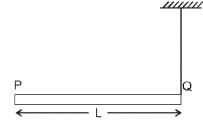
[2013]

A particle is projected with a velocity v, so that its range on a horizontal plane is twice the greatest height attained. If g is acceleration due to gravity, then its range is
An object is said to be in uniform motion in a straight line if its displacement
Two cars are moving in same direction with speed of 30 kmph. They are separated by a distance of 5 km. What is the speed of a car moving in opposite direction if it meets the two cars at an interval of 4 min?
A body starts from rest, the ratio of distances travelled by the body during 3rd and 4thseconds is :
The magnetic field associated with a light wave is given, at the origin, by B = B0 [sin(3.14 × 107)ct + sin(6.28 × 107)ct]. If this light falls on a silver plate having a work function of 4.7 eV, what will be the maximum kinetic energy of the photo electrons ?
(c = 3 × 108 ms-1, h = 6.6 × 10-34 J-s)
One mole of an ideal monoatomic gas is compressed isothermally in a rigid vessel to double its pressure at room temperature, 27°C. The work done on the gas will be:
The electric field at a point associated with a light wave is E = (100 Vm −1) sin [(3.0 ×1015 s(-1))t] sin [(6.0×1015 s(−1))t]. If this light falls on a metal surface having a work function of 2.0 eV, what will be the maximum kinetic energy of the photo electrons?
A ray of light is incident at an angle of 60° on one face of a prism of angle 30°. The emergent ray of light makes an angle of 30° with incident ray. The angle made by the emergent ray with second face of prism will be:
Both the nucleus and the atom of some element are in their respective first excited states. They get de-excited by emitting photons of wavelengths λN and λA, respectively. The ratio λN/λA is closest to:
A gravity meter can detect change in acceleration due to gravity (g) of the order of 10-9%. Calculate the smallest change in altitude near the surface of the earth that results in a detectable change in g. Radius of the earth R = 6.4 x 106m.
The diagram of a logic circuit is given below. The output F of the circuit is given by:
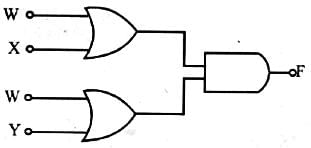
In the circuit shown in the Figure, cell is ideal and R2 = 100Ω. A voltmeter of internal resistance 200Ω reads V12 = 4 V and V23 = 6 V between the pair of points 1 - 2 and 2 - 3 respectively. What will be the reading of the voltmeter between the points 1 - 3.

The astronomical phenomenon when the planet Venus passes directly between the Sun and the earth is known as Venus transit. For two separate persons standing on the earth at points M and N, the Venus appears as black dots at points M' and N' on the Sun. The orbital period of Venus is close to 220 days. Assuming that both earth and Venus revolve on circular paths and taking distance MN = 1000 km, calculate the distance M'N' on the surface of the Sun.
[Take (2.75)1/3 = 1.4]
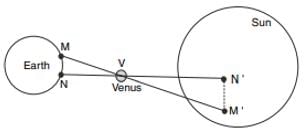
Consider the following figure:

Which of the following labelled points in the figure given above indicate an unstable state of an object?
A straight wire of length L and radius a has a current I. A particle of mass m and charge q approaches the wire moving at a velocity v in a direction anti parallel to the current. The line of motion of the particle is at a distance r from the axis of the wire. Assume that r is slightly larger than a so that the magnetic field seen by the particle is similar to that caused by a long wire. Neglect end effects and assume that speed of the particle is high so that it crosses the wire quickly and suffers a small deflection θ in its path. Calculate θ.
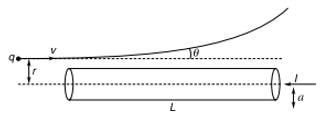
A water barrel having water up to depth 'd' is placed on a table of height 'h'. A small hole is made on the wall of the barrel at its bottom. If the stream of water coming out of the hole falls on the ground at a horizontal distance 'R' from the barrel, then the value of 'd' is:
A small soap bubble of radius 4 cm is trapped inside another bubble of radius 6 cm without any contact. Let P2 be the pressure inside the inner bubble and P0 be the pressure outside the outer bubble. Radius of another bubble with pressure difference P2 - P0 between its inside and outside would be
A planet of mass M is revolving around sun in an elliptical orbit. If dA is the area swept in a time dt, angular momentum can be expressed as
A particle is projected upward from the surface of earth (radius = R) with a speed equal to the orbital speed of a satellite near the earth’s surface. The height to which it would rise is
A spherical hole is made in a solid sphere of radius R. The mass of the original sphere was M.The gravitational field at the centre of the hole due to the remaining mass is
Three particles P, Q and R placed as per given figure. Masses of P, Q and R are √3 m, √3 m and m respectively. The gravitational force on a fourth particle ‘S’ of mass m is equal to
A cylindrical tank has a hole of diameter 2r in its bottom. The hole is covered wooden cylindrical block of diameter 4r, height h and density ρ/3.
Situation I : Initially, the tank is filled with water of density ρ to a height such that the height of water above the top of the block is h1 (measured from the top of the block).
Situation II : The water is removed from the tank to a height h2 (measured from the bottom of the block), as shown in the figure.
The height h2 is smaller than h (height of the block) and thus the block is exposed to the atmosphere.

Q. Find the minimum value of height h1 (in situation 1), for which the block just starts to move up?
If the elastic limit of copper is 1.5 × 108 N/ m2, determine the minimum diameter a copper wire can have under a load of 10.0 kg if its elastic limit is not to be exceeded.
A circular steel wire 2.00 m long must stretch no more than 0.25 cm when a tensile force of 400 N is applied to each end of the wire. What minimum diameter is required for the wire? Young's modulus for steel: E = 20 × 1010 Pa .
At what temperature is the r.m.s velocity of a hydrogen molecule equal to that of an oxygen molecule at 47°C?
Heat generated through a resistive wire will increase _______ times in unit time, if current in the wire becomes twice.











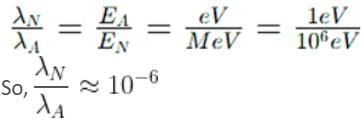














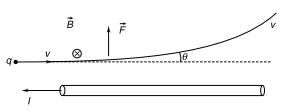








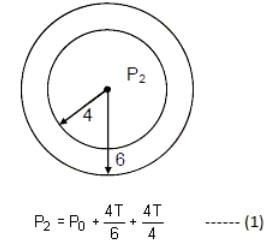


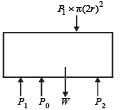


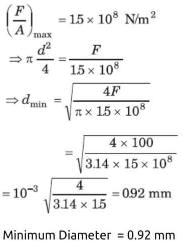
 E = 20 × 1010 Pa .
E = 20 × 1010 Pa .














